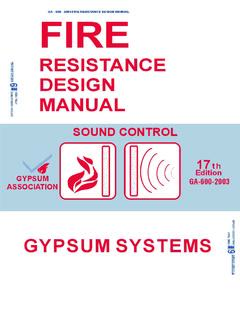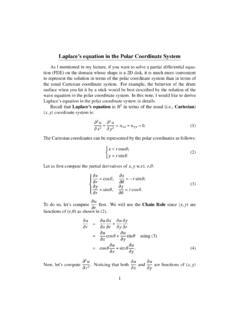Transcription of Chapter 13 OPEN-CHANNEL FLOW - Ira A. Fulton College of ...
1 Chapter 13 OPEN-CHANNEL Flow PROPRIETARY MATERIAL. 2014 by McGraw-Hill Education. This is proprietary material solely for authorized instructor use. Not authorized for sale or distribution in any manner. This document may not be copied, scanned, duplicated, forwarded, distributed, or posted on a website, in whole or part. 13-1 Solutions Manual for Fluid Mechanics: Fundamentals and Applications Third Edition Yunus A. engel & John M. Cimbala McGraw-Hill, 2013 Chapter 13 OPEN-CHANNEL FLOW PROPRIETARY AND CONFIDENTIAL This Manual is the proprietary property of The McGraw-Hill Companies, Inc.
2 ( McGraw-Hill ) and protected by copyright and other state and federal laws. By opening and using this Manual the user agrees to the following restrictions, and if the recipient does not agree to these restrictions, the Manual should be promptly returned unopened to McGraw-Hill: This Manual is being provided only to authorized professors and instructors for use in preparing for the classes using the affiliated textbook. No other use or distribution of this Manual is permitted. This Manual may not be sold and may not be distributed to or used by any student or other third party.
3 No part of this Manual may be reproduced, displayed or distributed in any form or by any means, electronic or otherwise, without the prior written permission of McGraw-Hill. Chapter 13 OPEN-CHANNEL Flow PROPRIETARY MATERIAL. 2014 by McGraw-Hill Education. This is proprietary material solely for authorized instructor use. Not authorized for sale or distribution in any manner. This document may not be copied, scanned, duplicated, forwarded, distributed, or posted on a website, in whole or part. 13-2 Classification, Froude Number, and Wave Speed 13-1C Solution We are to define normal depth and how it is established.
4 Analysis In open channels of constant slope and constant cross-section, the fluid accelerates until the head loss due to frictional effects equals the elevation drop. The fluid at this point reaches its terminal velocity, and uniform flow is established. The flow remains uniform as long as the slope, cross-section, and the surface roughness of the channel remain unchanged. The flow depth in uniform flow is called the normal depth yn, which is an important characteristic parameter for OPEN-CHANNEL flows . Discussion The normal depth is a fairly strong function of surface roughness. 13-2C Solution We are to discuss how pressure changes along the free surface in OPEN-CHANNEL flow.
5 Analysis The free surface coincides with the hydraulic grade line (HGL), and the pressure is constant along the free surface. Discussion At a free surface of a liquid, the pressure must be equal to the pressure of the gas above it. 13-3C Solution We are to determine if the slope of the free surface is equal to the slope of the channel bottom. Analysis No in general. The slope of the free surface is not necessarily equal to the slope of the bottom surface even during steady fully developed flow. Discussion However, there are situations called uniform flow in which the conditions here are met.
6 13-4C Solution We are to discuss some reasons for nonuniform flow in open channels, and the difference between rapidly varied flow and gradually varied flow. Analysis The presence of an obstruction in a channel such as a gate or a change in slope or cross-section causes the flow depth to vary, and thus the flow to become varied or nonuniform. The varied flow is called rapidly varied flow (RVF) if the flow depth changes markedly over a relatively short distance in the flow direction (such as the flow of water past a partially open gate or shortly before a falls), and gradually varied flow (GVF) if the flow depth changes gradually over a long distance along the channel .
7 Discussion The equations of GVF are simplified because of the slow changes in the flow direction. Chapter 13 OPEN-CHANNEL Flow PROPRIETARY MATERIAL. 2014 by McGraw-Hill Education. This is proprietary material solely for authorized instructor use. Not authorized for sale or distribution in any manner. This document may not be copied, scanned, duplicated, forwarded, distributed, or posted on a website, in whole or part. 13-313-5C Solution We are to discuss the driving force in OPEN-CHANNEL flow and how flow rate is determined. Analysis Flow in a channel is driven naturally by gravity. Water flow in a river, for example, is driven by the elevation difference between the source and the sink.
8 The flow rate in an open channel is established by the dynamic balance between gravity and friction. Inertia of the flowing fluid also becomes important in unsteady flow. Discussion In pipe flow, on the other hand, there may be an additional driving force of pressure due to pumps. 13-6C Solution We are to discuss the difference between uniform and nonuniform flow. Analysis The flow in a channel is said to be uniform if the flow depth (and thus the average velocity) remains constant. Otherwise, the flow is said to be nonuniform or varied, indicating that the flow depth varies with distance in the flow direction.
9 Uniform flow conditions are commonly encountered in practice in long straight sections of channels with constant slope and constant cross-section. Discussion In uniform OPEN-CHANNEL flow, the head loss due to frictional effects equals the elevation drop. 13-7C Solution We are to explain how to determine if a flow is tranquil, critical, or rapid. Analysis Knowing the average flow velocity and flow depth, the Froude number is determined from gyV/Fr . Then the flow is classified as Fr < 1 Subcritical or tranquil flow Fr = 1 Critical flow Fr > 1 Supercritical or rapid flow Discussion The Froude number is the most important parameter in OPEN-CHANNEL flow.
10 13-8C Solution We are to discuss whether the flow upstream of a hydraulic jump must be supercritical, and whether the flow downstream of a hydraulic jump must be subcritical. Analysis Upstream of a hydraulic jump, the upstream flow must be supercritical. Downstream of a hydraulic jump, the downstream flow must be subcritical. Discussion Otherwise, the second law of thermodynamics would be violated. Note that a hydraulic jump is analogous to a normal shock wave in that case, the flow upstream must be supersonic and the flow downstream must be subsonic. Chapter 13 OPEN-CHANNEL Flow PROPRIETARY MATERIAL.





